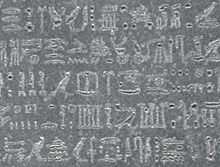Ptolemaic Decrees
The Ptolemaic Decrees were a series of three decrees issued by the Hellenistic Ptolemaic dynasty, which ruled Egypt from 305 BC to 30 BC. The first decree was issued by Ptolemy III (the Decree of Canopus), the second by Ptolemy IV (The Memphis Stele), and the third by Ptolemy V. The Rosetta Stone is a well-known example of one of the texts; it was included in the Third Decree. Multiple copies of the decrees, inscribed on stone stelae, were erected in temple courtyards, as specified in the text of the decrees.
There exist three copies plus a fragment of the Decree of Canopus, two copies of the Memphis Decree (one imperfect), and two and a half copies of the text of the Rosetta Stone, including the copy on the Nubayrah Stele and a pyramid wall inscription with edits, or scene replacements, completed by subsequent scribes.

239 BC Decree of Canopus (Ptolemy III), (247–221 BC)
The Decree was issued on 7 Appellaios (Mac.) = 17 Tybi (Eg.) year 9 of Ptolemy III = 7 March 238.
- Stone 1: Stele of Canopus, (no. 1), found 1866, 37 lines of hieroglyphs, 74 lines of Demotic (right side), 76 lines of Greek 'capitals', fine limestone.
- Stone 2: Stele of Canopus (no. 2), found 1881, 26 lines hieroglyphs, 20 lines Demotic, 64 lines Greek 'capitals', white limestone.
- 3rd partial text with lines of hieroglyphs (now in the Louvre).
- 4th text was discovered in 2004 at Bubastis, by the German-Egyptian 'Tell Basta Project'.
217 BC Decree of Memphis (Ptolemy IV), (221–203 BC)
- Stone 1: Raphia Decree, found 1902 at the site of ancient Memphis, hieroglyphs, Demotic, and Greek, dark granite.
- Stone 2: Pithom Stele, No. II, found 1923, hieroglyphs (front), 42 lines Demotic (back), virtually complete, providing an almost total translation, and Greek (side), sandstone.
196 BC Decree of Memphis (Ptolemy V), (203–198 BC)
- Stone 1: Stele of Rosetta, "The Rosetta Stone", found 1799, (remaining) hieroglyphs, 14 lines, 32 lines Demotic, 54 lines Greek 'capitals', dark granite-(granodiorite).
- Stone 2: Stele of Nubayrah, found in the early 1880s, hieroglyphs, lines 1-27 were used to complete the missing lines on the Rosetta Stone, Demotic, Greek capitals, limestone.
- Site 3: the Temple of Philae, inscribed hieroglyphs from the Third Decree on walls, also overwritten, with scenes and figures of humans/gods.